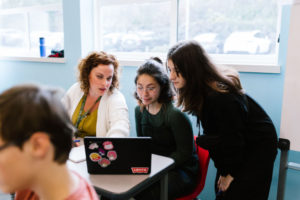Here is why I stayed

I’m a Founding Teacher at Summit Atlas. Here’s Why I’ve Stayed.
By Rachel Henty
When I joined the Summit Atlas team in 2016, it was my third time helping found a charter school. I moved to Seattle to be closer to the mountains and the great outdoors. When I got here, I didn’t know what the future held for my teaching career. Then I met the folks who were building Summit Atlas. Seven years later, I’m still here!
I knew Summit Atlas would be different from the schools I founded in New Orleans. I liked the innovative learning platform, and the idea of teaching cognitive skills that apply across grade levels. But what has kept me here is the school culture.
When I started at Summit Atlas, my experience of professional development was sitting in a room and being lectured or coached. But here, teachers learn the same way our students do: This is an organization where everyone—from the newest student to the most senior staff member—is encouraged to learn, coach, and self-reflect. Every day I learn something new, whether it’s receiving feedback from my students, or practicing complex conversations with my colleagues (without sounding like we’re reading from a “how-to” book on workplace communication).
I can see that culture of growth every day in my 6th and 7th grade math classes. Many of my students have had previous negative experiences with math instruction. When they first walk into my classroom, I can see them panicking in their seats. At Summit, that anxiety melts away. Students can retake tests if they need to. They know they won’t be penalized for making mistakes if they grow and learn from them. When that pressure comes off, kids’ brains open up. Six weeks into the school year, students who came to my class disliking math, now have their hands in the air.
The teacher mentoring approach at Summit is special. In the school’s first three years, my mentor pod was entirely middle school boys, many of whom were really struggling with interpersonal relationships. Over time, I figured out what teachers they were likely to click with, what subject areas they were going to thrive or struggle in, and where they needed to advocate for themselves. I saw those young men grow incredibly in their ability to have positive relationships, to control their emotions, and to trust other people. Now that they’ve moved on, I’m forming those deep relationships with new groups of students every three years.
My connection to Summit Atlas goes beyond school walls. I live where I work, in West Seattle, and the faces in my classroom reflect my neighborhood. In a school that’s racially diverse, I’m learning and growing as a member of the community. Sometimes that means being uncomfortable–learning to question my own biases, and taking hard feedback from families about ways I can be more culturally sensitive towards their children. But this is also such a joyful, warm, welcoming place to live and work. Creating a learning space that meets the needs of a diverse study body is one of the greatest tools Summit has given me. Seeing young people relate to each other across identities and cultures gives me hope for the future!
Summit Atlas is just one school in a sea of hundreds in Washington state. But since we opened our doors, this school has changed not only my life, but the lives of so many people in West Seattle. It’s a unique part of our community, a place where students come to become lifelong learners. I’m so proud to have helped found Summit Atlas, and I plan to continue teaching and learning here for many years to come.

